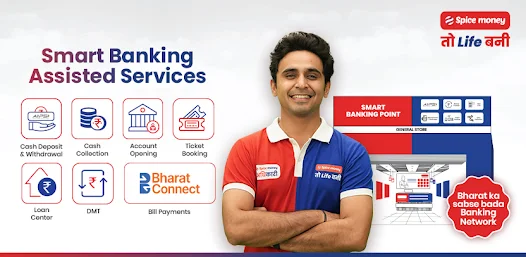Kiosk banking has emerged as a transformative solution to address the financial needs of underserved populations, particularly in remote or rural areas where traditional banking infrastructure is limited. With the advent of the kiosk banking app, financial services are now more accessible than ever, bridging the gap between unbanked individuals and essential financial tools. Kiosk banking enables users to perform basic banking transactions without needing to visit a physical bank branch, thus simplifying financial access for millions.

This innovative approach leverages small-scale outlets equipped with internet connectivity and specialized software to deliver banking services. By empowering local vendors or entrepreneurs to operate as banking representatives, kiosk banking eliminates geographical and infrastructural barriers. It has proven to be a reliable and cost-effective model to promote financial inclusion across diverse regions.
What is Kiosk Banking?
Kiosk banking refers to a model of branchless banking wherein individuals can access essential financial services through dedicated kiosks or outlets. These kiosks are equipped with necessary technology and are operated by authorized representatives to assist customers with their transactions. The core objective of kiosk banking is to make banking services more accessible, particularly for the underprivileged and underserved communities.
Some of the key services provided through kiosk banking include:
- Account opening
- Cash deposits and withdrawals
- Fund transfers
- Balance inquiries
- Utility bill payments
- Mini statements
The kiosk banking app enhances this experience further by providing a user-friendly interface that simplifies transactions, making it a practical solution for individuals unfamiliar with traditional banking methods.
How Kiosk Banking Works
Kiosk banking operates on a partnership model between financial institutions and local entrepreneurs or vendors. These vendors, often referred to as banking correspondents (BCs), act as intermediaries between customers and banks. Here’s how the process works:
- Setup of Kiosks: Banks collaborate with local vendors to set up kiosks in areas with limited banking infrastructure.
- Technology Integration: The kiosk is equipped with necessary hardware, such as biometric scanners, printers, and internet connectivity, along with the kiosk banking app for seamless operations.
- Service Delivery: Customers visit the kiosk to avail themselves of various banking services. Transactions are processed through the app, ensuring speed and accuracy.
- Support and Guidance: The banking correspondent assists users in understanding and utilizing the services, making the experience smooth for first-time or less tech-savvy customers.
Benefits of Kiosk Banking
Kiosk banking has brought a plethora of benefits to both customers and financial institutions. Some of the most notable advantages include:
For Customers
- Accessibility: Kiosk banking eliminates the need to travel long distances to access banking services, particularly for rural communities.
- Ease of Use: With the kiosk banking app, transactions are simplified, making it easier for users to manage their finances.
- Cost-Effective: Customers save on transportation and other costs associated with visiting bank branches.
- Financial Inclusion: It provides banking access to those who were previously excluded from the formal financial system.
For Financial Institutions
- Expansion of Reach: Banks can serve a larger customer base without incurring the costs of setting up and maintaining physical branches.
- Increased Customer Base: By targeting underserved populations, banks can expand their market share.
- Operational Efficiency: The kiosk banking model reduces overhead costs and streamlines service delivery.
Challenges in Kiosk Banking
While kiosk banking has numerous benefits, it also faces certain challenges:
- Technical Issues: Connectivity problems or hardware malfunctions can hinder smooth operations.
- Awareness: Many potential users remain unaware of kiosk banking and its benefits.
- Security Concerns: Ensuring the safety of financial transactions is critical, especially in remote areas.
- Training of Operators: Proper training for banking correspondents is essential to ensure reliable service delivery.
The Role of Technology in Kiosk Banking
Technology plays a pivotal role in the success of kiosk banking. The kiosk banking app is a cornerstone of this model, providing an intuitive interface for both operators and users. Features such as biometric authentication, real-time transaction updates, and multi-language support enhance the overall experience and security of the platform.
Additionally, advancements in mobile technology and internet connectivity have further streamlined kiosk banking operations. These technological innovations ensure that financial services remain accessible, efficient, and secure for all users.
Future of Kiosk Banking
The future of kiosk banking looks promising as it continues to evolve and adapt to changing consumer needs. With the integration of advanced technologies such as artificial intelligence, machine learning, and blockchain, kiosk banking is expected to become even more efficient and user-friendly.
Financial institutions are also likely to expand their kiosk banking networks to cover more remote areas, ensuring that no community is left behind in the journey toward financial inclusion. Moreover, the kiosk banking app will continue to be refined, offering enhanced features and a more seamless user experience.
Conclusion
Kiosk banking has revolutionized the way financial services are delivered, particularly to underserved populations. By leveraging technology and local partnerships, it has simplified financial access and brought millions of people into the formal banking ecosystem. The kiosk banking app has further enhanced this model, providing a user-friendly and efficient platform for transactions.
As the world moves toward greater financial inclusion, kiosk banking will play a pivotal role in bridging the gap between traditional banking and unbanked communities. Its cost-effective and accessible approach ensures that everyone, regardless of their location or financial background, can benefit from essential banking services. Through continuous innovation and expansion, kiosk banking is set to remain a cornerstone of inclusive financial growth.